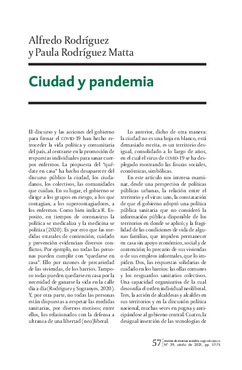Ciudad y pandemia
City and pandemic

Visualizar/
Data
2021-04Autor
Rodríguez, Alfredo; Rodríguez Matta, PaulaMetadata
Mostrar registro completoResumo
Durante 2020 quedó de manifiesto la importancia de considerar la escala territorial en la aplicación de políticas sanitarias para contener el Covid-19. El desconocimiento del gobierno respecto del grado y magnitud de la segregación y fragmentación de Santiago de Chile fue evidente en las distintas medidas que adoptó para hacer frente a los distintos conflictos asociados a la pandemia. Prueba de esto fue la insistencia en el confinamiento en los hogares, una medida que demostró su insuficiencia
para frenar el avance de los contagios. Los motivos de este fracaso fueron varios; entre ellos, el bajo nivel de adhesión al gobierno y su descrédito en amplios sectores en la ciudad, la fragilidad de las condiciones de vida de muchas familias, la precariedad de un gran conjunto de viviendas y el alto porcentaje de informalidad laboral. Pero, por otro lado, en este período también se levantaron organizaciones barriales de cuidado, subsistencia, solidaridad y resistencia, las que resignificaron sus territorios. Junto con ellas, las autoridades locales apoyaron y lideraron medidas de prevención y apoyo, muchas veces en pugna y anticipándose al gobierno central. Frente a tal situación, las preguntas que se han levantado durante este primer año pandémico son: ¿quién gobierna la ciudad?; ¿quién la desmercantiliza?; ¿quién cuida en la ciudad y a quiénes? During 2020, the importance of considering the territorial scale in the application of health policies to contain Covid-19 became clear. The government’s ignorance of the degree and magnitude of Santiago’s segregation and fragmentation was evident in the different measures it adopted to deal with the situation. Proof of this was the insistence on home confinement, which was insufficient to stop the advance of the pandemic. The reasons for this failure were various; among them, the low level of adherence to the government and its discredit in broad sectors of the city, the fragility of the living conditions of many families, the precariousness of housing and the high percentage of informal employment. But, on the other hand, in this period neighborhood organizations of care, subsistence,
solidarity and resistance also arose, which re-signified their territories. In the neighborhoods, local authorities supported and led prevention and support measures, often in conflict with and anticipating the central government. Faced with such a situation, the questions that have arisen during this first pandemic year are: Who governs the city? Who de-commodifies it? And, who cares in the city and who?
